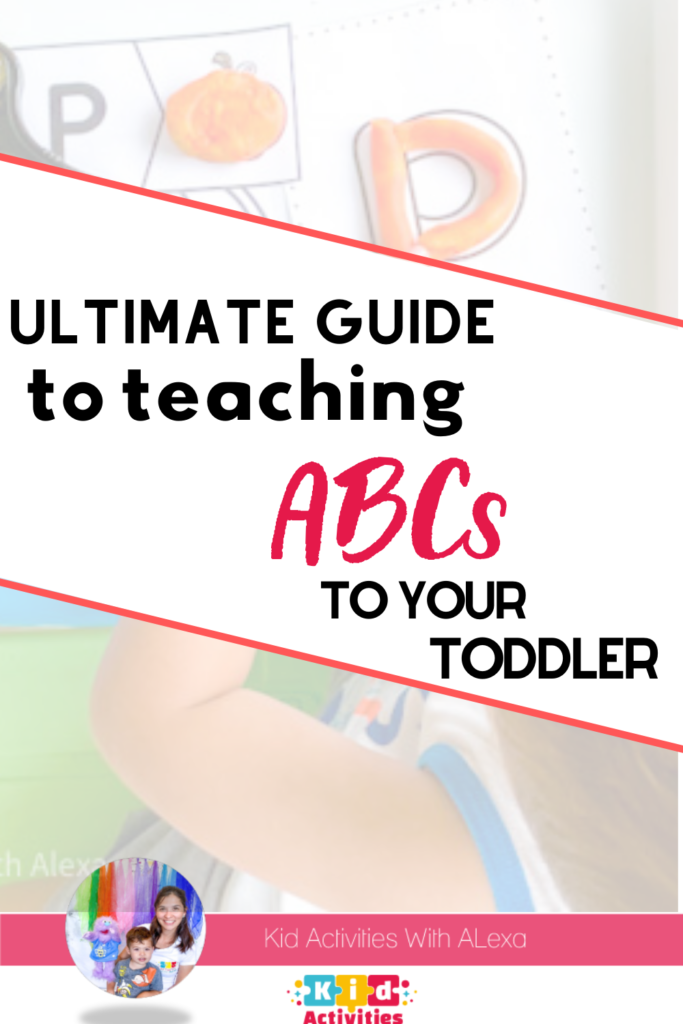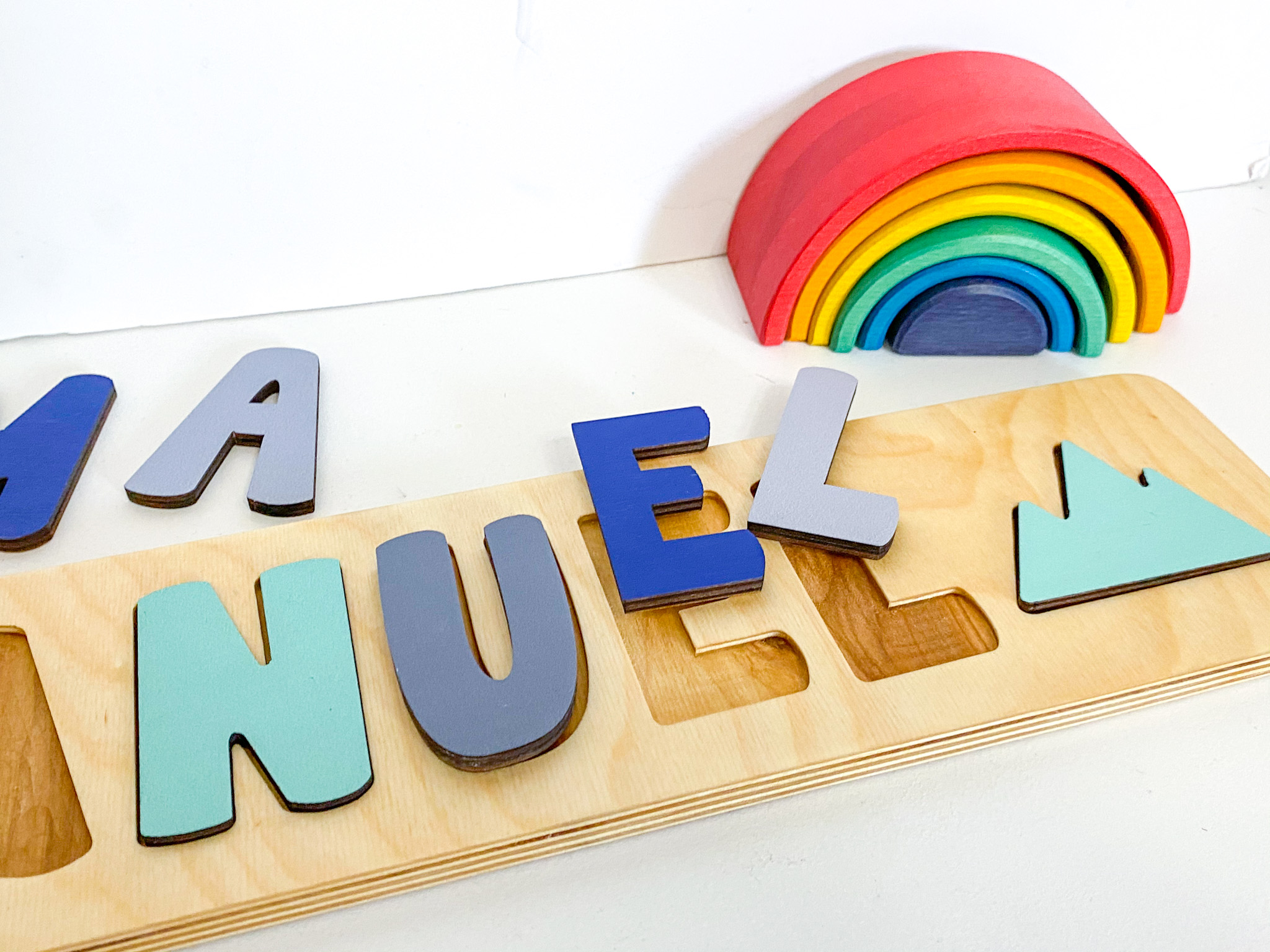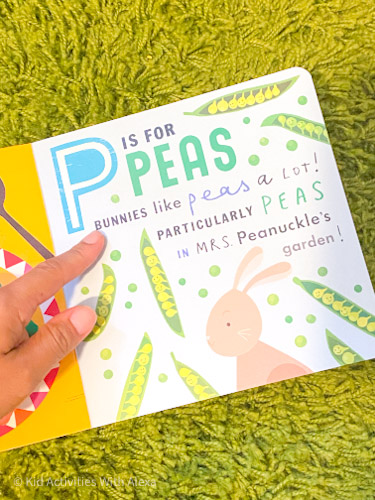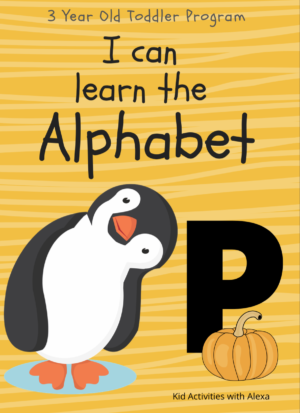If you are looking for the step by step guide on how to teach the alphabet to a toddler, look no further! This is the ultimate guide and will give you all the steps you need to go from zero to recognizing letters.
Is it just me with anxiety when it comes to start teaching? there are so many resources out there but everything seems to be broken down in pieces?
What do I do first? what letters? upper case? lower case? do I d letter of the week? do I pick a theme?
If you want to start teaching the ABCs but don’t know where to start or how, follow along. When I started searching for answers I found a lot of activities but not a clear direction on what to do first and how to move forward. I did my research, I consulted with Pre-K teachers, put It all together in an easy to follow path.
This ultimate guide will answer all your questions, give you a path to follow and ease up the anxiety.
To help you get started teaching the alphabet to a toddler, this article will discuss how you can introduce the alphabet to a toddler for the first time, What letters to teach first, and finishing with various activity ideas to fast-track their learning.
For us teaching the alphabet came at closer to three years old but for you it might come earlier or later. It really doesn’t matter, kid develop at different times and that is true when it comes to earning Preschool concepts too.
How do you know if your toddler is ready for learning the alphabet?
Before you start teaching the alphabet you want to make sure your toddler is developmentally ready for it. There is no point in creating a bunch of activities about letters if your child could care less about the letter at this time.
The very step in learning the alphabet is to start with letter recognition.
In order to evaluate if a toddler was ready for letter recognition activities, leave letters around the house. Take out those alphanet puzzles you have, the letter magnets for the bathtub and the magnet ones for the refrigerator.
Things to notice:
Will he/she be attracted to the letters? Will he/she bring it to you and ask “what is this”, will he/she play and arrange the letters. Basically, is your child interested?
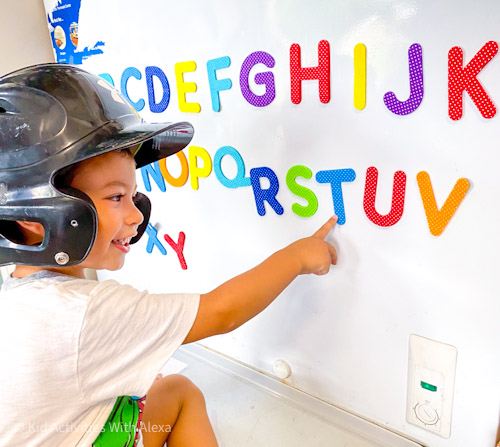
For a while, he could care less about these letters, but once he hit 2.5 and we started working on recognizing numbers, he quickly shifted to asking me “what letter is this” as he grabbed one and gave it to me.
BINGO!
That was my sign he was ready to start learning the alphabet!
When should a child recognize letters of the alphabet?
- By age 3: Kids start recognizing some letters and can sing or say aloud the “ABC” song.
- By age 4: Kids may recognize about half the letters in the alphabet and start to connect letters to their sounds. (Like s makes the /s/ sound.)
- By age 5: Kids often know all the letters of the alphabet and their correct order.
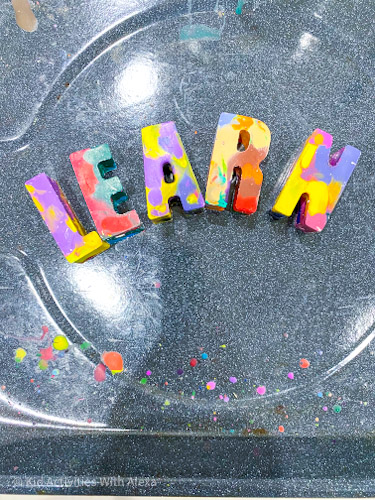
Methods to teach the ABCs
Start Teaching letter recognition first of their first name
The first step in getting exposure to the alphabet is to start working on letter recognition. This means, that a child can see a letter and identify what letter it is and what sound does it make.
Write your child’s name in a paper with a yellow highlighter and laminate it. Each morning, grab a marker and review each of the letters as you mark them. Have them practice the tracing. You can place your hand over his/hers as you practice.
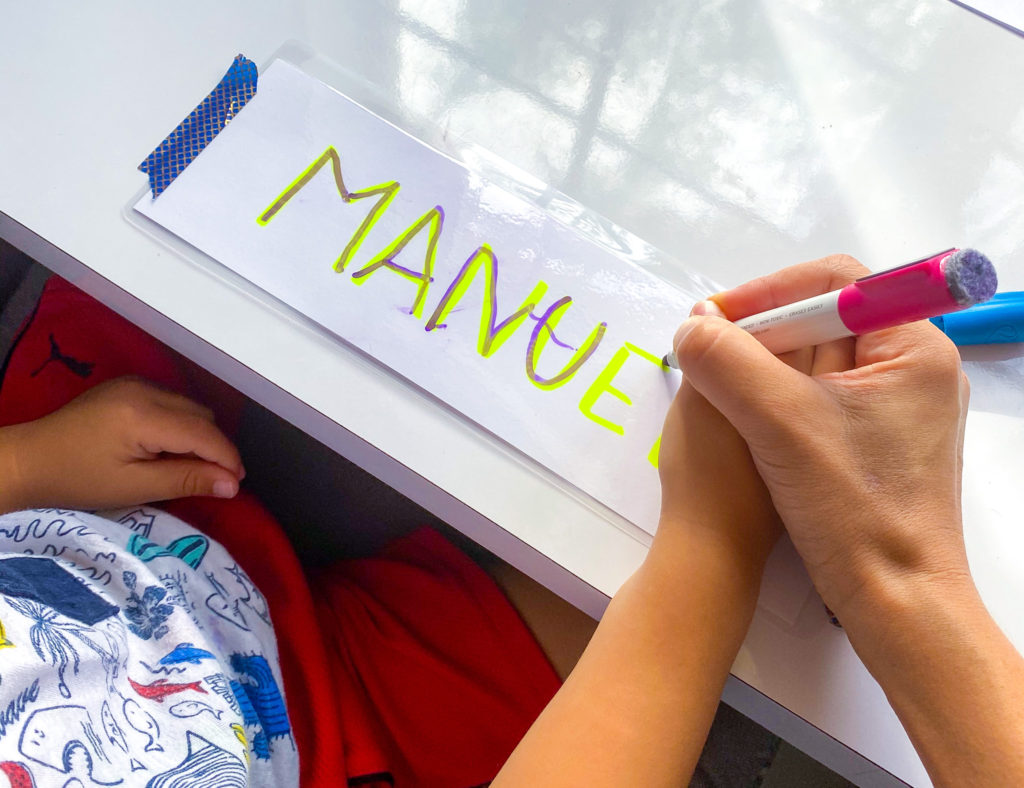
In which order Do I teach the letters?
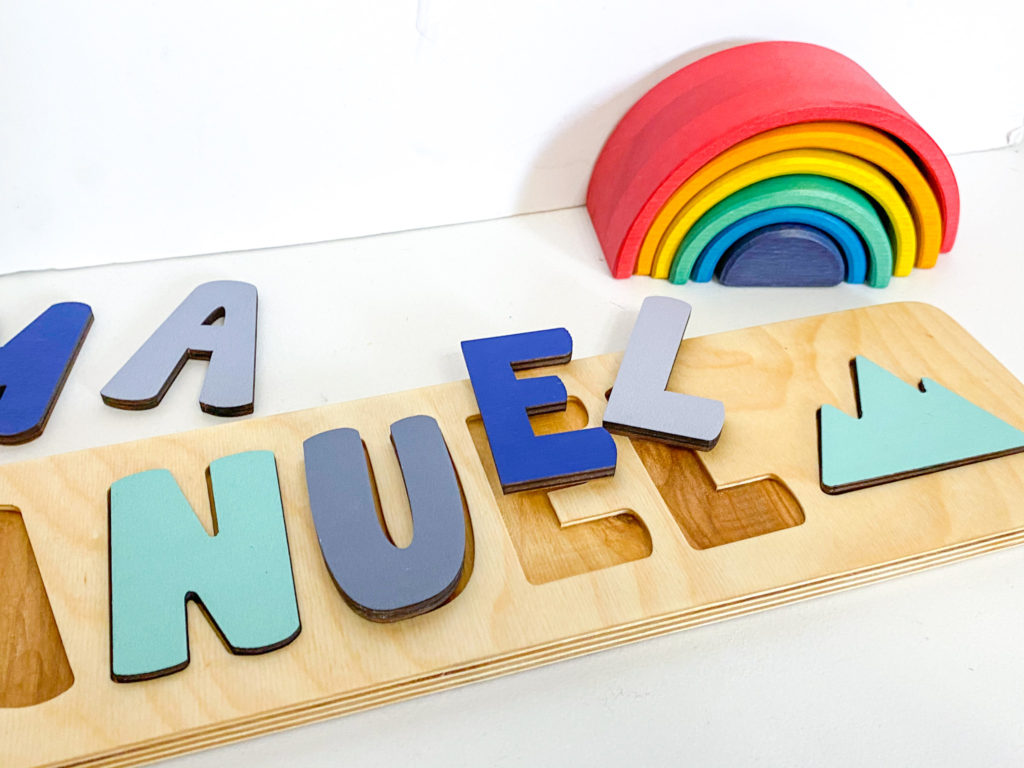
In an ideal world, you would start the alphabet from the beginning, in chronological order. However, despite popular belief, this is not the best way of teaching the alphabet to a toddler. To increase memory function, alongside sparking interest, it’s advised to teach the letters of their name first.
Begin by slowly introducing the letters of their name. Their name is very special to them and it attached meaning to them. perhaps after saying their name. For example, “Manuel” your name starts with M, mmm this is the letter M.
Repetition is key; the more you can repeat this, the better and quicker they will begin to associate that letters have meaning, even if this is subconscious.
There are various other activities you can use to teach them the letters of their name, too. For example, you could read activity books, placing greater emphasis on these letters, get creative with some alphabet-themed arts and crafts, or begin naming objects and spelling these out as you go.
In essence, it’s all about creating a fun and rewarding learning environment. This stimulates learning, allowing your toddler to progress quickly, best preparing them for their lower years of school and life.
Should I teach capital or lowercase letters to introduce the alphabet?
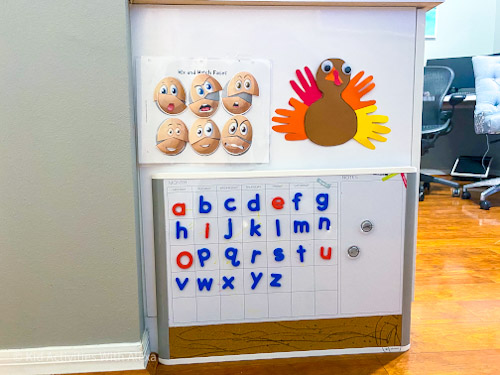
Some people say that lowercase letters should be taught before uppercase ones. Their argument is that they are exposed to the lower case letters more often than the upper, and that’s a valid point.
But…. I also learned that:
Lowercase letters are more complex and are harder to draw compared to uppercase letters. It is also, more common to see on books they read and sighs around their town.
The Handwriting Without Tears Method (I researched and fell in love with their system, and although implemented mostly at schools, it is a method I will be implementing at home and creating worksheets and activities based on their system).
This system says that when teaching upper letters you will recognize 4 common shapes. Little stick, big stick, little curve and big curve.
Upper letter cases all start at them same place, while lowercase letters have many shapes and every letter start in different places.
I was sold on that technique! I definitely want to make it easier for my child to start recognizing letters so we will start with uppercase letters.
I want my child to be able to build upper case letter with wooden sticks without having to learn how to write them first, and this method seems easy to grasp.
Do you have to start with either or? Not at all. You can do them both, choose one or the other. The fist step is to get them expose to the letters as much as you can. Point them out and show what sound does the letter make as well as things and animals associated with each letter.
What to teach after their name?
The Jolly Phonics Program is a proven, fun, and multi-sensory method of learning used to excel children’s learning in both reading and writing from an early age. After teaching your toddler, the letters of their name, adopting this method is an excellent next step. This method consists of teaching groups of letters in sets;
the entire phonics programme can be seen below:
- s, a, t, i, p, n
- c, k, e, h, r, m, d
- g, o, u, l, f, b
- ai, j, oa, ie, ee, or
- z, w, ng, v, 00, oo
- y, x, ch, sh, th, th
- qu, ou, oi, ue, er, ar
SAVE IT! PIN IT! REMEMBER IT
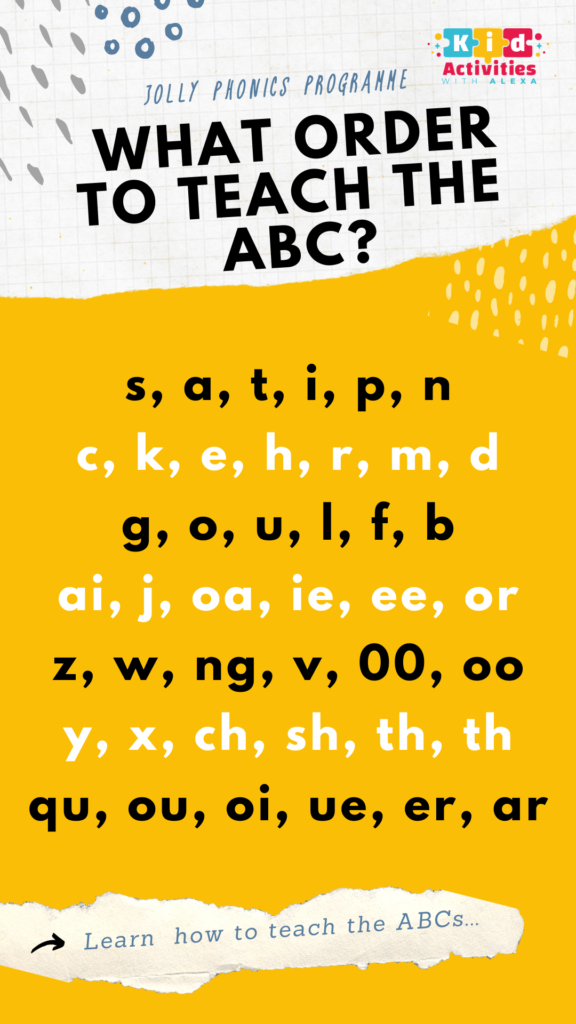
Jolly Phonics is a widely popular method in the United Kingdom, however, also used in various schools and pre-schools in the U.S. Past studies have shown great success with this method when you teach the ABCs to 3 year old, resulting in improved selling, comprehension skills, reading, writing, and whole word phonics, from a young age.
Furthermore, this method or similar adaptations allow toddlers to begin forming whole words quickly. After learning a small minority of the phonics, children can begin forming words, such as: “at,” “in,” and “an.”
Introducing these letters one by one, and as quickly as possible (this is entirely individual-based) creates a sense of pride and accomplishment for your child. There’s no better feeling than understanding, and for a parent, watching your child learn and utilise their new words in everyday life.
Over time, after repetition has kicked in, your toddler will begin forming whole words with ease, perfecting the sounds, and perhaps actions that go with them. This can be difficult, however, ensure your child is ready to learn, becoming less frustrated and more likely to actively participate.
Remember: repetition is the key to success. Whilst it’s okay to have a day off once in a while, ensure to resume a regular schedule to fast-track their learning. Oh, and remember to keep it fun – that’s the heart of stimulation!
When your toddler starts showing show an interest in learning the alphabet here are a few ideas of fun activities you can introduce to aid the learning process.
Fun Activities to teach the ABCs to 3 year old
These activities can be centered around multiple letters, or individual letters, spending more or less time on each one depending on how quickly they pick it up.
Alongside these individual tasks, implementing regular reading with your toddler is an excellent way to increase comprehension and phonic skills.
Use flashcards to Teach ABCs

Using flashcards to create games is a great way for visual associations of each letter.
Flashcards help with the visualization and association of each letter with an object, piece of fruit, or person. For example, “a” could be associated with an apple or an animal, such as an 🍎 apple.
Try to look for flashcards that are simple and visually attractive. Get two sets. This way, you can play a variety of games. Start by matching the images, and then moving on to matching the image that is associated with each letter. Lastly, move on to match letters.
Start with only 2 sets, and move on gradually adding more as your toddler starts learning and recognizing more letters.
Use Sensory activities to learn the alphabet
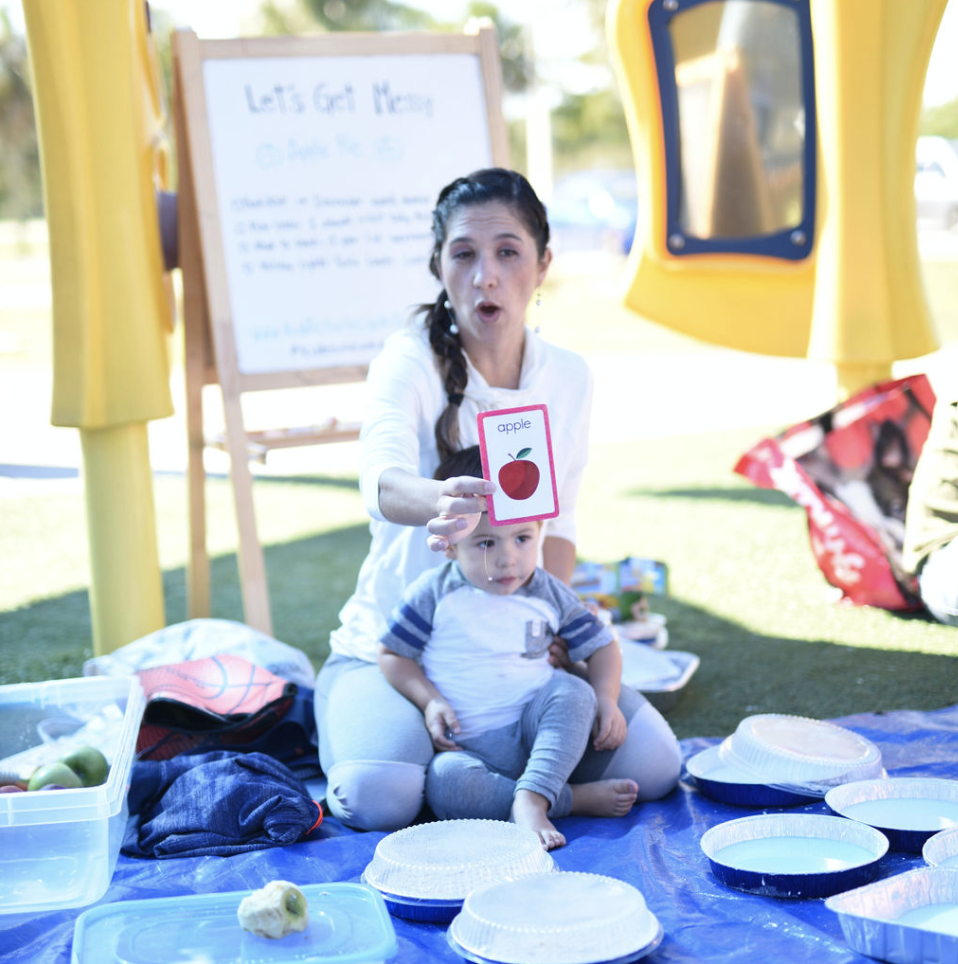
A favorite of mine is teaching using sensory play. Creating activities around a letter will allow time for them to play, explore and really soak in the information. I have done full sensory classes to talk about the letter A as pictured above. We did an messy apple pie, activity, had apples and flashcards and letter A puzzles laying around. They fully dove into (literally) into the letter A.
You can recreate this with any letter, creating fun sensory bins.
Use playdough Mats to learn the ABCs
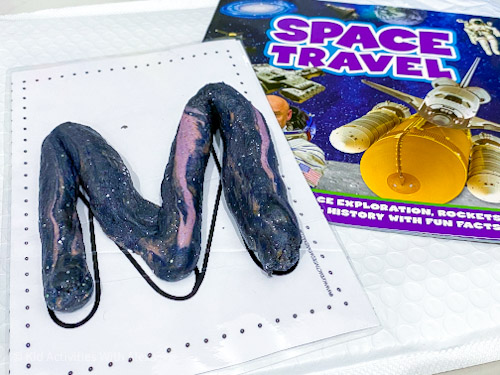
Not feeling like getting messy with a sensory bin? another great idea is the use of playdough. Playdough is a great activity for hand motor skill development which eventually will translate in learning how to hold a pencil, tie their shoes, buttoning a jacket among other things.
Use playdough mats to trace each letter with the playdough. You can do these by combining the mat with a theme like we did above for the letter M. We made galaxy playdough because our theme was THE MOON.
-
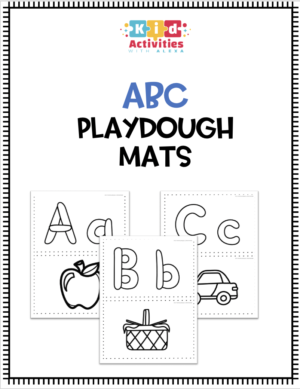 ABC Playdough Mats$5.00
ABC Playdough Mats$5.00
.
Use Games to teach the alphanet
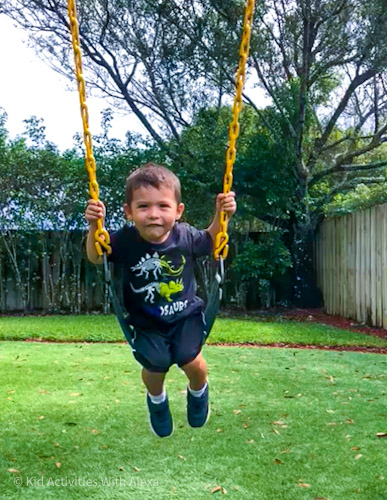
A fun and easy game you can play is naming objects. This can be done anywhere and requires no equipment, also making for a great road trip game. Each time you spot an object, animal, say the sound of the letter it starts with with your toddler repeating this motion. Mmm-Mmm-Mmm is for Monkey. Focus on the sounds of the letters, as this is what their most responsive too.
We do this often as a game during our letter of the week while we are on the swing. I stand in from and while the swing comes closer to me I say a word that starts with the letter we are working on. Example: Mmm-Mmm-Mmm is for Moon
While the swing goes back, is his turn to repeat. Do it a few times and they will catch on. Suddenly, your toddler will want to be interested in learning more words that start with that letter so that he can participate in saying new words.
While there are other better methods out there, this is a quick and easy one that you can do while having fun. And besides, repetition and learning through fun is key to successful and engaging learning.
Use ABC books to teach the alphabet
You’ve probably already have a few ABC books at home. This is similar to flashcard activity; for example, the letter “a” may contain a picture of an apple. Reading these books regularly is a great way to reinforce pre-existing knowledge and association of the letter A sound with the word apple.
As a general rule of thumb: aim to read these books at least once to two times a week, more if your toddler requests them, as they usually do! Even if they are more focused on the images, ensure to point out and read out each letter and the associated object. It’s about exposing them to the letters as much as we can and pointing the letters to slow down and recognize each one.
This strengthens knowledge and subconsciously contributes to a better understanding of the alphabet and individual letters as a whole.
Use the ABC song but make it fun!
Rhymes and songs can be extremely effective, so be sure to implement these to reinforce your child’s alphabet learning.
It’s well-known and a widely acknowledged fact that rhymes are an important part for language development, well they are a great tool for learning the ABCs as well.
A fun way I learned you can sing the abc and make it fun is to do it as if other animals are singing.
Say woof woof woof instead of abc.. as you point each letter on a poster. This sure grabbed by son’s attention more at the beginning than singing the ABCs as I followed the poster.
When singing the ABCs using a poster, grab a stick or a spoon and tap each one as you sing. This way they can visually see the letter and associate it with how it looks.
A fun activity we do is that each morning, my son gets to pick what we use to point to the letters. Sometimes is a stick we painted and decorated together and another days is a spooky skeleton hand we got during Halloween.
My son loves o be the one who points as we sing, so I guide his hand as we do. This technique for him more interested and focused!
Use Poems and Rhymes
Besides from singing the ABC song, use poems and make up your own rhymes that reinforce what sounds start with each letter.
Don’t worry, you don’t need to come up with these by yourself, unless of course, you’re feeling creative!
This one we used for our Letter of the week M.
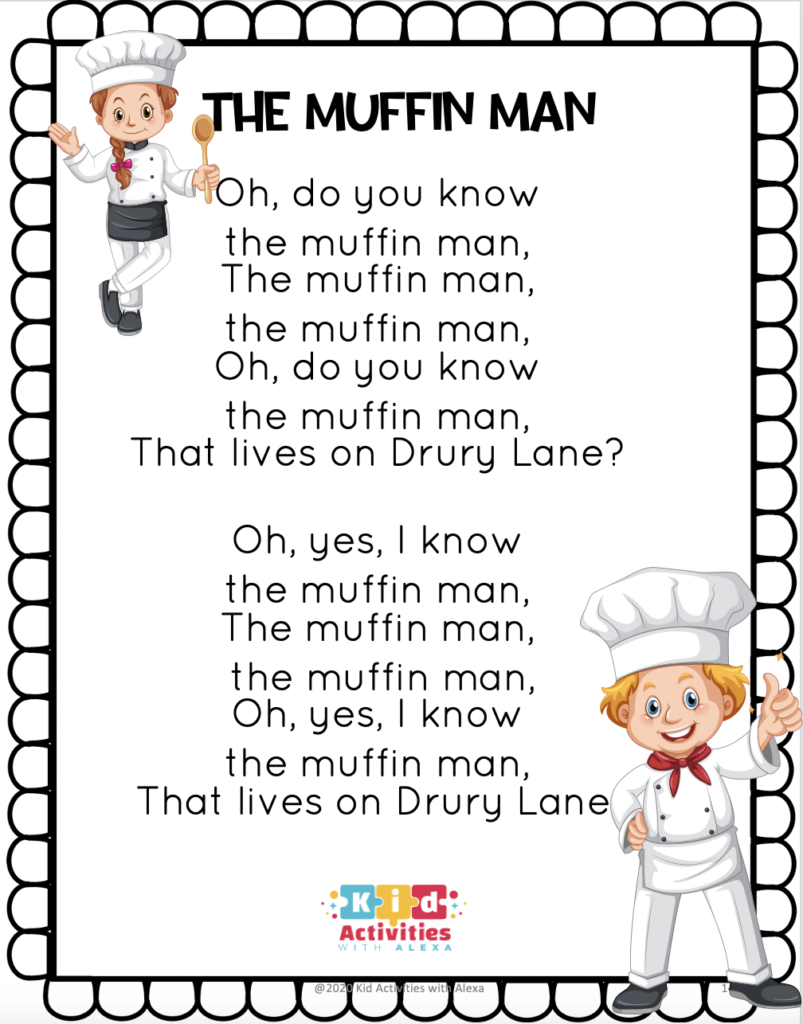
Often, these rhymes and songs will be paired with follow-along dances, actions, and animations. These are designed to get your child actively involved in the learning process.
If they need to remember a specific letter, they will refer back to the song in their mind in search of the letter or piece of information they are looking for.
Use crafts to learn Letters
Kids learn through doing, and crafts are often a very exciting activity for them. They get explore their creative side and the brain is able to make connections between the left and right side.
If you are following the letter of the week approach or a theme a week approach, you can implement letter crafts.
Create an alphabet book
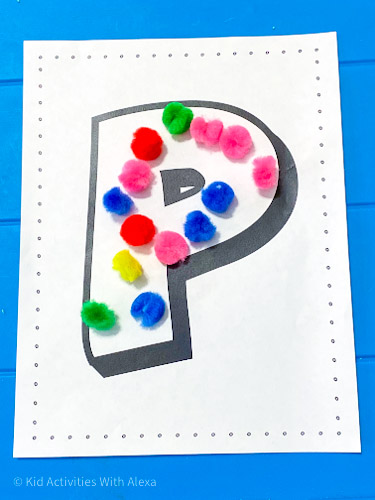
Print out one letter per page and glue items that start with that letter onto the paper. Or you can create different animals or objects using the letter as a base.
Use printables and coloring pages
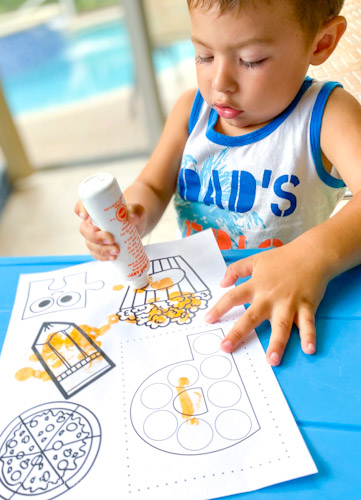
Coloring pages and printable worksheets are fun to use from time to time. Get your favorite markers, watercolors, stickers and use coloring pages featuring the letters and things that start with each letter. The above was one of the pages we used for our letter P weekly activities.
Last thought on introducing the alphabet to a toddler
Around the ages of two and three, your toddler may begin to take an interest in learning, in particular, the alphabet. Teaching the alphabet can be fun when using creative activities like matching, sensory bins, playdough mats, printables and crafts. No matter what activities you choose, by implementing various fun and interactive activities letter recognition will come naturally.
Remember that we are starting to teach them that words have meaning and words are made up of letters.
Start by teaching your child the letters that make their name up followed by the Jolly phonics program. This is immersive and fun, and creates an excellent stepping stone and drive for wanting to learn other letters.
Teach lowercase first, as this is easier to teach and to learn. Unlike uppercase letters, lowercase is much simpler, both in design and understanding. Ensure not to mix the two up, or this could cause confusion for your toddler.
Remain consistent with your approach, reinforcing repetition in whatever method you choose. To experience the greatest success, fast-tracking their learning of the alphabet, implement a variety of activities, whether that’s reading books, listening to nursery rhymes, creating fun songs, or engaging in various arts and crafts.
Most importantly, however, remain patient with your toddler. It takes time to learn; some kids have it easier than others. But if you stick with it, they will eventually get it, at their own pace.
Pin this Post
Help other parents looking for ways to teach the alphabet. Share on Pinterest! so they can easily find this resource.
